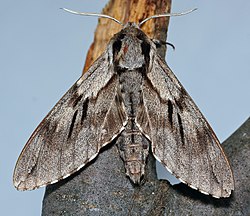| Pine hawk-moth | |
|---|---|
 | |
| Scientific classification | |
| Kingdom: | Animalia |
| Phylum: | Arthropoda |
| Class: | Insecta |
| Order: | Lepidoptera |
| Family: | Sphingidae |
| Genus: | Sphinx |
| Species: | S. pinastri |
| Binomial name | |
| Sphinx pinastri | |
| Synonyms | |
| |
Sphinx pinastri, the pine hawk-moth, is a moth of the family Sphingidae. It is found in Palearctic realm and sometimes the Nearctic realm. This species has been found in Scotland but is usually found in England. [2] The species was first described by Carl Linnaeus in his 1758 10th edition of Systema Naturae.
Contents
The larvae feed on Scots pine, Swiss pine, Siberian pine and Norway spruce.





